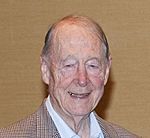Tom Kibble facts for kids
Quick facts for kids
Sir Tom W. B. Kibble
|
|
|---|---|
 |
|
| Born | 23 December 1932 |
| Died | 2 June 2016 (aged 83) |
| Nationality | British |
| Alma mater | University of Edinburgh, BSc, MA, PhD |
| Known for | Quantum field theory, Broken symmetry, Higgs Boson, Higgs mechanism, and Cosmology |
| Awards | Dirac Medal Sakurai Prize |
| Scientific career | |
| Fields | Theoretical physics |
| Institutions | Imperial College London |
| Thesis | Topics in quantum field theory: 1. Schwinger's action principle; 2. Dispersion relations for inelastic scattering processes (1958) |
| Doctoral advisor | John Polkinghorne |
Sir Thomas Walter Bannerman "Tom" Kibble (born December 23, 1932 – died June 2, 2016) was a British scientist. He was a professor of theoretical physics at Imperial College London. He was knighted in 2014 for his important work in physics.
Sir Tom Kibble studied how the universe works. He was interested in quantum field theory, which looks at tiny particles. He also studied cosmology, which is the science of the whole universe.
He is famous for helping to describe the Higgs mechanism. This idea explains why some tiny particles have mass, or weight. He also researched topological defects. These are like tiny cracks or twists in space.
From the 1950s, he cared deeply about the nuclear arms race. Later, he worked to show that scientists have a duty to society.
Contents
Early Life and School
Tom Kibble was born in Madras, India. His grandfather was a doctor in India. His grandmother was the writer Helen Bannerman.
He went to school in Madras, India. Then he moved to Edinburgh, Scotland. He studied at Melville College and the University of Edinburgh. He earned his first degree in 1955. He got his PhD in 1958. Tom Kibble married Anne Allan in 1957. They had three children. Anne passed away in 2005.
His Work in Physics
Kibble studied how things change in the universe. He looked at symmetry breaking. Imagine a ball at the top of a hill. It could roll down in any direction. This is a simple example of symmetry breaking.
He also studied phase transitions. This is like water turning into ice when it freezes. He researched topological defects. These are like tiny flaws or jumps in space.
The Higgs Mechanism
Sir Tom Kibble is best known for helping to discover the Higgs mechanism. This idea helps explain why some tiny particles have mass. He also helped predict the Higgs boson. This is a special particle that is key to the Higgs mechanism.
His work on the Higgs theory was very important. It was recognized as a milestone in physics. For this discovery, he won the 2010 Sakurai Prize. Some people felt he should have shared the Nobel Prize in Physics in 2013. Even Nobel winner Peter Higgs said he was disappointed Kibble wasn't included.
Cosmic Strings and the Early Universe
Kibble was a pioneer in studying how topological defects formed. He looked at how they appeared in the very early universe. A key idea is the Kibble-Zurek mechanism. This explains how defects form during certain phase changes.
He also introduced the idea of cosmic strings into modern cosmology. These are like line-shaped defects in space on a huge scale.
Kibble helped lead research programs. These programs studied how defects in the early universe are like defects in liquids and solids. Scientists can study these in a lab. For example, the tiny boundaries between crystals in a metal are like these defects.
In 1966, Kibble wrote a textbook called Classical Mechanics. It is still used today.
Awards and Honors
Sir Tom Kibble received many awards for his work. He was a Fellow of the Royal Society starting in 1980. He was also a member of the American Physical Society.
Some of his awards include:
- The Hughes Medal (1981)
- The Rutherford Medal (1984)
- The Guthrie Medal (1993)
- The Dirac Medal (2013)
- The Albert Einstein Medal (2014)
- The Royal Medal of the Royal Society of Edinburgh (2014)
He was made a Commander of the Order of the British Empire (CBE) in 1998. He was knighted in 2014 for his contributions to physics.
Scientists and Society
In the 1950s and 1960s, Tom Kibble worried about the nuclear arms race. From 1970, he became a leader in groups that promoted the social responsibility of scientists.
He believed scientists should think about how their work affects the world. He was involved with groups like the British Society for Social Responsibility in Science. He also worked with Scientists against Nuclear Arms. He was a sponsor of Scientists for Global Responsibility.
He helped organize a big meeting for scientists in 1988. This meeting focused on the role of science in society.
- Imperial College People
See also
 In Spanish: Tom Kibble para niños
In Spanish: Tom Kibble para niños

